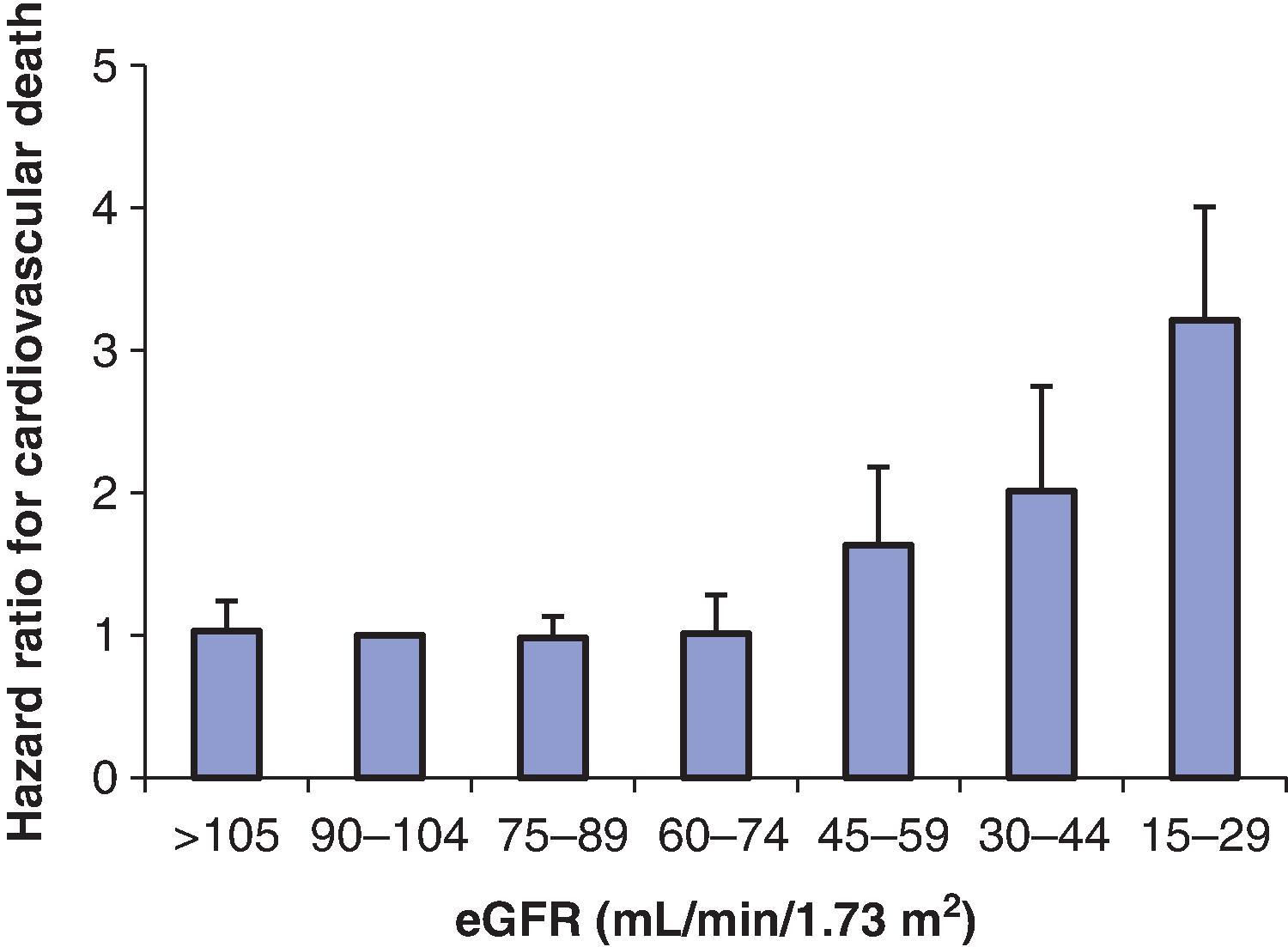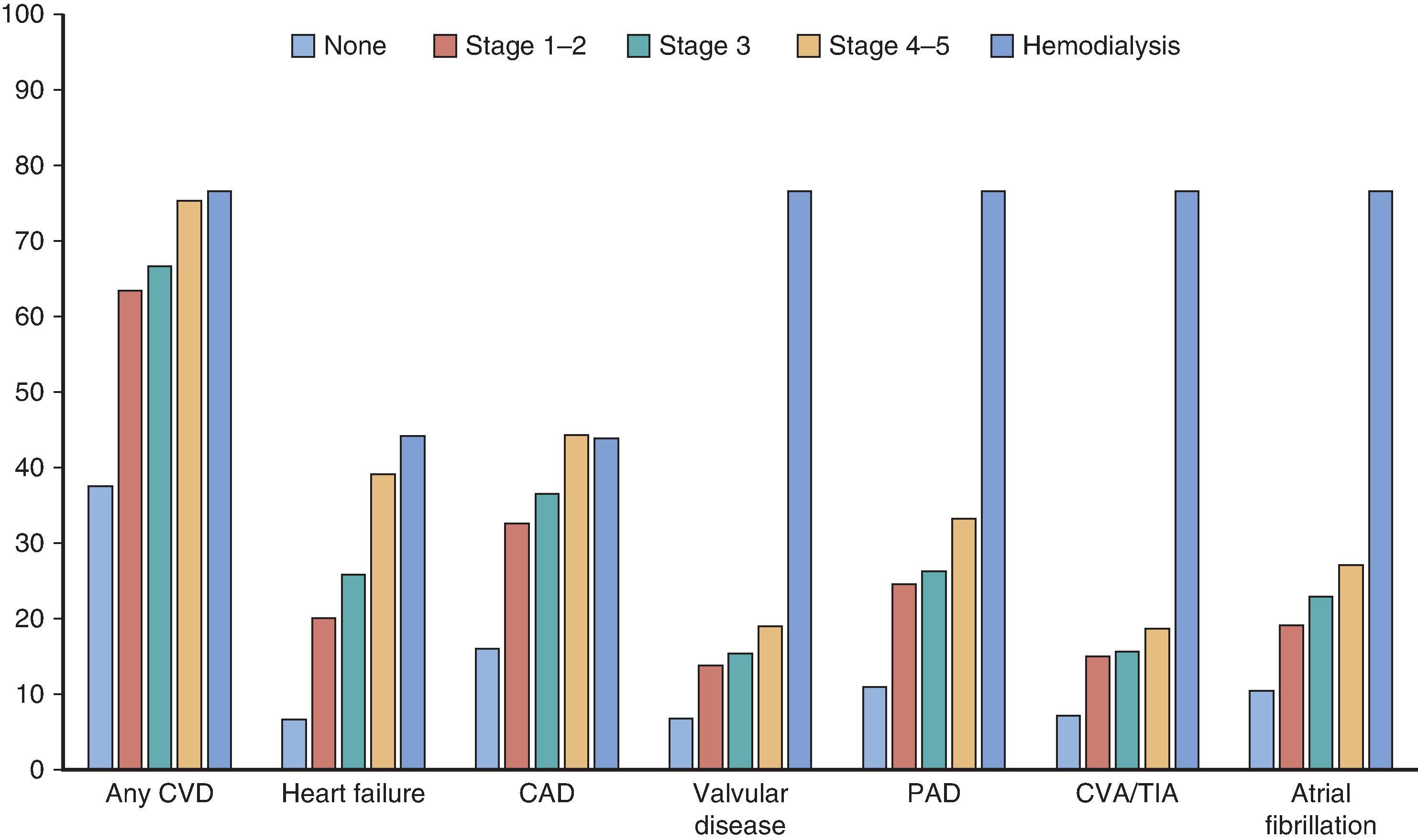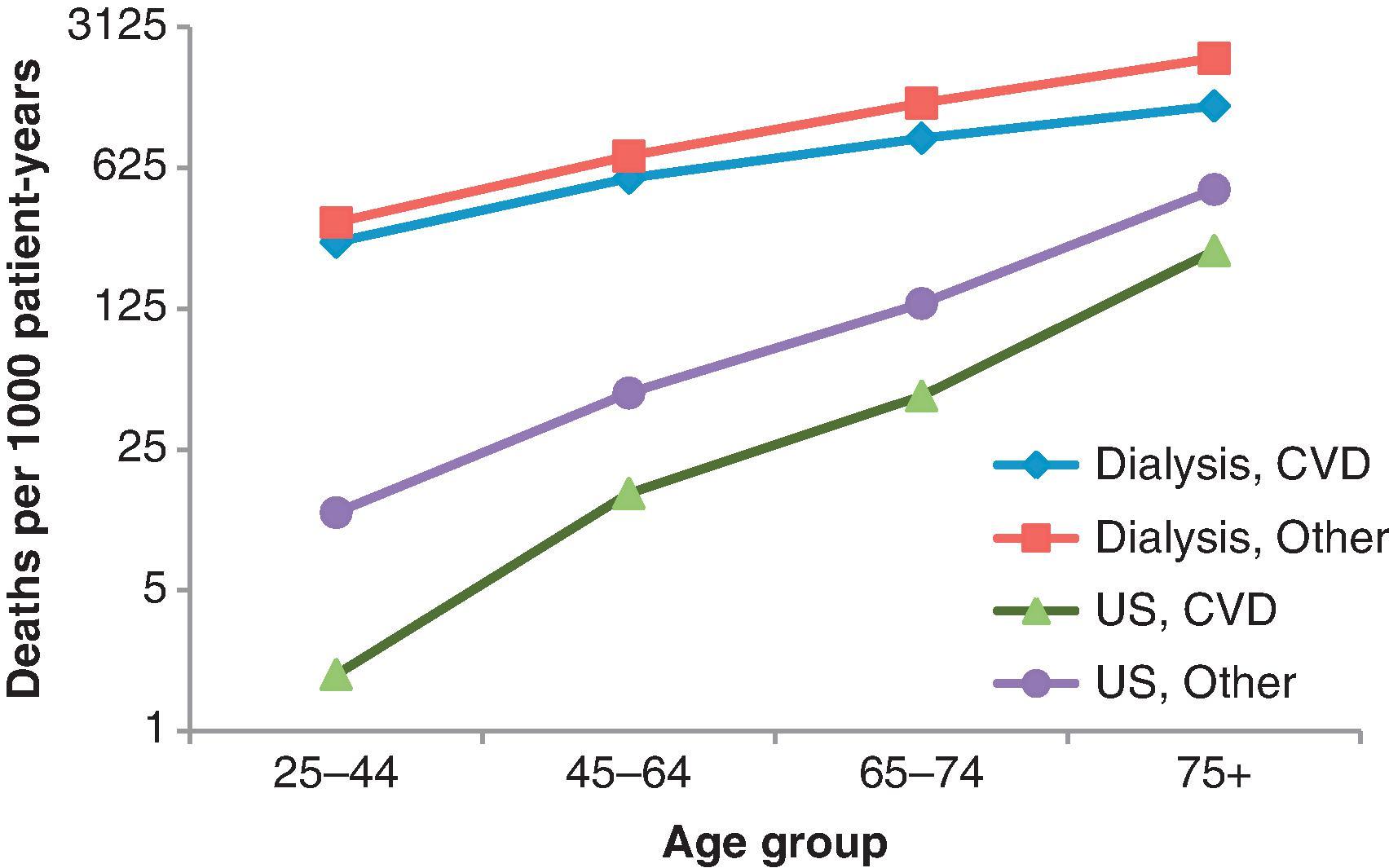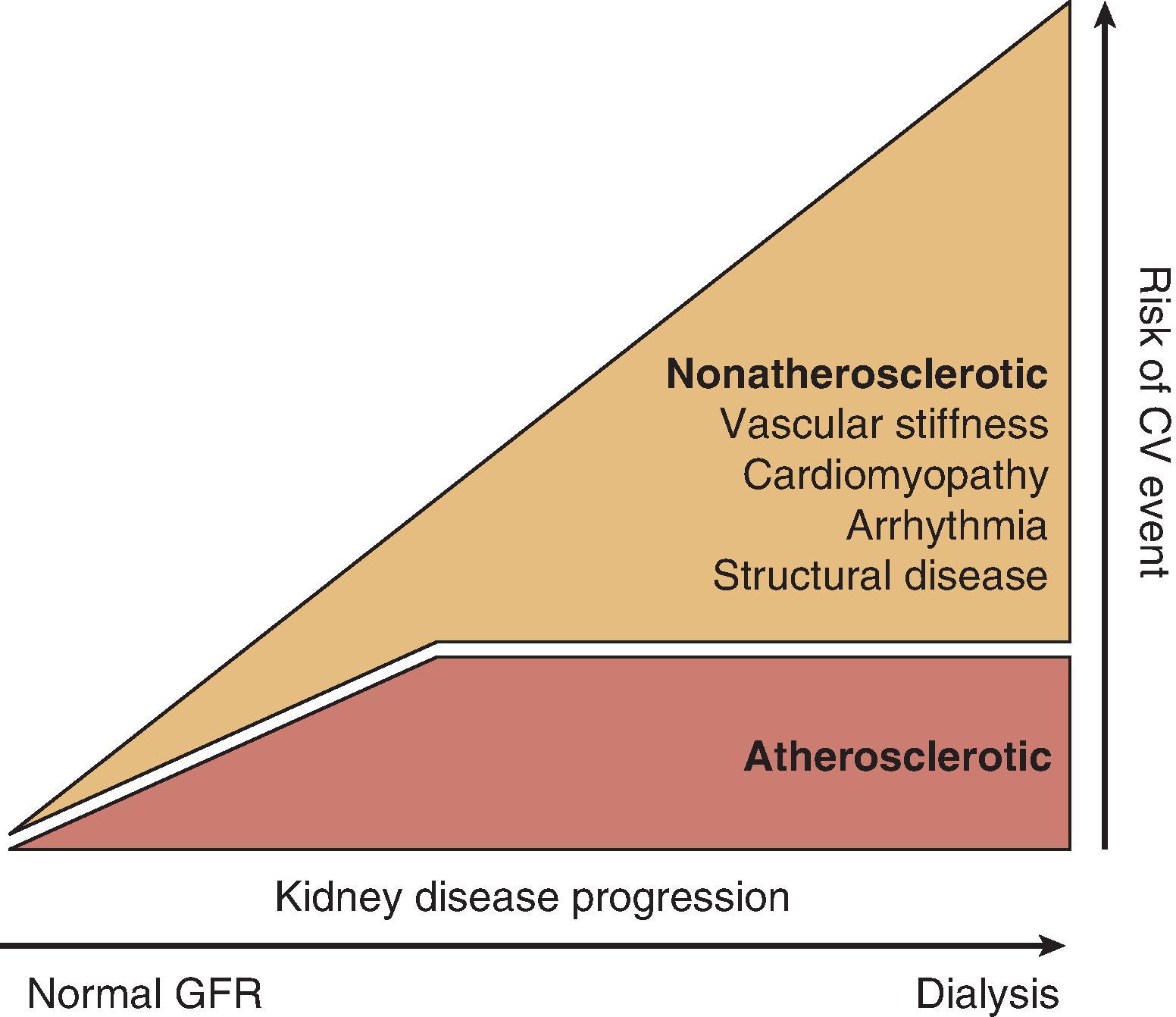Physical Address
304 North Cardinal St.
Dorchester Center, MA 02124
Cardiovascular disease is the leading cause of death across the spectrum of chronic kidney disease (CKD), with increased risk seen in individuals with reduced glomerular filtration rate (GFR) and in those with even minimally elevated urine albumin excretion. There is a high incidence and prevalence of atherosclerotic disease and nonatherosclerotic disease, ischemic heart disease, heart failure and left ventricular hypertrophy (LVH), valvular diseases, and arrhythmia in individuals with CKD, with prevalence increasing as GFR declines, and the interplay among these contributes to heightened overall cardiovascular disease risk among those with CKD. The risk of cardiovascular disease outcomes increases as kidney function declines, with the risk of cardiovascular death in patients undergoing dialysis 10 to 20 times that of the general population. This chapter focuses largely on individuals with reduced GFR, acknowledging that albuminuria both identifies individuals with CKD and is a very strong predictor of cardiovascular disease risk at all levels of kidney function, including individuals with CKD stages G1 through G3a where metabolic sequelae of reduced GFR are not yet clinically apparent.
Manifesting with cardiac ischemia, heart failure, and arrhythmia, cardiovascular disease is overwhelmingly the leading cause of morbidity and mortality in individuals with CKD. Among individuals with reduced GFR, there is a progressive increase in the age-standardized incidence of cardiovascular disease events as kidney function declines, such that, compared with an age-standardized baseline rate of 21 cardiovascular events per 1000 person-years in individuals with estimated glomerular filtration rate (eGFR) greater than 60 mL/min/1.73 m 2 , rates increase to 37, 113, 218, and 366 events per 1000 person-years among people with eGFR of 45 to 59 (CKD stage G3a), 30 to 44 (CKD stage G3b), 15 to 29 (CKD stage G4), and less than 15 mL/min/1.73 m 2 (CKD stage G5), respectively. Even in analyses that adjust for demographic factors as well as cardiovascular risk factors such as diabetes, hypertension, albuminuria, and dyslipidemia, the risk of cardiovascular death is dramatically increased at lower GFR levels ( Fig. 54.1 ). The risk relationship between eGFR and cardiovascular disease events is independent of a person having preexisting cardiovascular disease.

These associations also are seen in individuals with functioning kidney transplants. Among kidney transplant recipients, each 5 mL/min/1.73 m 2 higher eGFR at levels below 45 mL/min/1.73 m 2 is independently associated with a 15% lower risk of both CVD. Similarly, the presence of albuminuria, independent of the eGFR level, is also associated with a higher risk of cardiovascular disease events among kidney transplant recipients.
The prevalence of cardiovascular disease in people with CKD is similarly high. Using Medicare data from the United States, after adjustment for age, sex, and race, CVD was present in 37.5% of patients without CKD compared with 63% of patients with diagnostic codes for CKD stages G1-G2 CKD, 67% of patients with CKD stage G3, and 75% of patients with CKD stages G4-G5 ( Fig. 54.2 ). Critically, both reduced eGFR and moderately increased albuminuria with preserved eGFR (urine albumin-to-creatinine ratio [UACR] 30 to 300 mg/g, indicating CKD stages G1 to G2) are independently associated with prevalent cardiovascular disease.

Cardiovascular disease may be subclinical in CKD populations; in Chronic Renal Insufficiency Cohort (CRIC) participants undergoing cardiac computed tomography, there was a graded increased risk of coronary artery calcification (CAC) with both lower eGFR and higher levels of albuminuria, even in individuals with no known history of cardiovascular disease, although the utility of CAC for identifying an atherosclerotic process in advanced CKD is uncertain. Similarly, in the elderly, the frequency of advanced atherosclerotic lesions on autopsy specimens increased as eGFR decreased (33.6% for eGFR ≥60 mL/min/1.73 m 2 , 41.7% for CKD stage G3a, 52.3% for CKD stage G3b, and 52.8% for CKD stage G4).
Vascular calcification likely has an important role in the pathogenesis of cardiovascular disease in people with CKD, with medial calcification increasingly prevalent in large arteries as GFR declines, although, even in individuals with longstanding kidney failure, it appears unusual to have medial coronary artery calcification. Medial calcification is particularly common in individuals with CKD and diabetes, and results in a process distinct from typical atherosclerotic mechanisms of vascular disease. Calcification likely reflects the interplay of multiple factors, including a procalcific milieu due to hyperphosphatemia and other factors as well as lower levels of calcification inhibitors, such as γ-carboxylated matrix gla protein and fetuin-A. This is discussed further in Chapter 53.
LVH is also common in CKD stages G3 and G4, likely reflecting pressure and volume overload. In CRIC, the prevalence of LVH assessed by echocardiography was 32% for eGFR above 60 mL/min/1.73 m 2 , rising to 48%, 57%, and 75% for eGFR categories 45 to 59, 30 to 44, and less than 30 mL/min/1.73 m 2 , respectively. These findings contrast with a prevalence of LVH of less than 20% in older adults in the general population.
Both incident and prevalent heart failure are common in people with CKD. Among adult members of a large group-model health maintenance organization in the northwestern United States, 6.0% of individuals with predominantly early CKD stage G3 had a diagnostic code for heart failure versus 1.8% in an age- and sex-matched population, while, in the Atherosclerosis Risk in Communities (ARIC) study, individuals with eGFR less than 60 mL/min/1.73 m 2 at baseline were at twice the risk of incident heart failure hospitalization and death compared with those with eGFR of ≥90 mL/min/1.73 m 2 , regardless of the presence of baseline coronary disease.
Other structural heart diseases seen commonly in CKD include aortic valve, mitral valve, and mitral annular calcification. Mitral valve or mitral annular calcification was present in 20% of individuals with reduced kidney function (roughly CKD stage G3 to G4) in the Framingham Offspring Study. In CRIC, lower eGFR was strongly associated with increased likelihood of mitral annular calcification, with risk increased by 50%, 130%, 226%, and 278% for eGFR categories 50 to 60, 40 to 50, 30 to 40, and less than 30 mL/min/1.73 m 2 , respectively, when compared with eGFR ≥60 mL/min/1.73 m 2 . Similar results were seen from a large echocardiography database from Duke, where mitral annular calcification was present in 24% of individuals with eGFR below 30 mL/min/1.73 m 2 . The Framingham Heart Study and other studies also show a high prevalence of aortic valve calcification in individuals with CKD, with CRIC demonstrating a “dose-dependent” association between lower eGFR and greater aortic valve calcification that was independent of traditional cardiovascular risk factors.
In patients undergoing dialysis, incident cardiovascular disease is common, with similar cardiovascular mortality rates in a 30-year-old patient undergoing dialysis and an 80-year-old individual from the general population ( Fig. 54.3 ). This likely reflects a high prevalence of cardiovascular disease (∼43% of prevalent dialysis patients in the United States in 2018 carried a diagnosis of coronary artery disease and ∼43% had a congestive heart failure diagnosis) as well as a high case-fatality rate compared with the general population.

The incidence and prevalence of LVH and heart failure are also extremely high among patients undergoing dialysis. More than 30% of participants in the Frequent Hemodialysis Network studies (a group that overall was healthier than the general dialysis population) had LVH at study entry, assessed with cardiac magnetic resonance imaging. Based on United States Renal Data System (USRDS) administrative data that rely on billing codes to identify heart failure events, the 2-year cumulative probability of developing heart failure for patients initiating dialysis in 2016 was 50% for hemodialysis patients and 36% for peritoneal dialysis patients.
Patients undergoing hemodialysis also have a high prevalence of valvular calcification. In one study, 45% of participants had calcification of the mitral valve, and 34% had calcification of the aortic valve; this compares with expected prevalence of 3% to 5% in the general population. Studies have demonstrated rates of mitral annular calcification ranging from 30% to 50% in patients undergoing hemodialysis.
Cardiovascular disease in individuals with CKD has a variety of manifestations, broadly conceptualized as atherosclerotic disease and nonatherosclerotic disease, with the latter incorporating increased vascular stiffness, cardiomyopathy, valvular disease, and arrhythmia ( Table 54.1 ). In most cases, clinically apparent cardiovascular disease reflects the interplay among these manifestations. Although there is limited consensus on terminology for arteriopathies, atherosclerosis can be defined as an occlusive disease of the vasculature that occurs because of the deposition of lipid-laden plaques, while vascular stiffness reflects nonocclusive remodeling of the vasculature accompanied by a loss of arterial elasticity. Both of these conditions may manifest with ischemic heart disease and heart failure, and clinical disease often reflects the concurrent presence of both atherosclerotic disease and vascular remodeling. Certain risk factors, including dyslipidemia, primarily predispose an individual to development and progression of atherosclerosis, whereas others, including elevated calcium-phosphorus product, may predispose to vascular stiffness. Volume overload and anemia can lead to cardiac remodeling and LVH, whereas hypertension, which is common at all stages of CKD, is associated with all of these disease manifestations. Over time, the interplay among these manifestations may yield both segmental perfusion defects due to disease affecting larger coronary arteries and insufficient subendocardial perfusion secondary to cardiac hypertrophy (causing increased demand) and capillary dropout. The end result is myocyte death, heart failure, and increased risk of arrhythmia.
| Cardiovascular Disease Type | Pathologic or Structural Manifestation | Risk Factors | Indicators/Diagnostic Test | Clinical Sequelae |
| Arterial disease | Atherosclerosis: Luminal narrowing of arteries because of plaques | Dyslipidemia Diabetes mellitus Hypertension Other traditional and nontraditional risk factors |
Inducible ischemia on nuclear imaging Cardiac catheterization |
Myocardial infarction Angina Sudden cardiac death Heart failure |
| Vascular stiffness: Diffuse dilatation and wall hypertrophy of larger arteries with loss of arterial elasticity | Hypertension Volume overload Hyperparathyroidism Hyperphosphatemia Other factors predisposing to medial calcification |
Vascular calcification Increased pulse pressure Aortic pulse wave velocity Cardiac computed tomography Other arterial imaging |
Myocardial infarction Angina Sudden cardiac death Heart failure LVH |
|
| Cardiomyopathy | LV hypertrophy: Adaptive hypertrophy to compensate for increased cardiac demand | Pressure overload Increased afterload because of hypertension, valvular disease, and arteriosclerosis Volume overload Volume retention because of progressive kidney disease ± anemia |
Echocardiography Cardiovascular magnetic resonance imaging |
Myocardial infarction Angina Sudden cardiac death Heart failure |
| Decreased LV contractility | Ischemic heart disease Hypertension LVH Other traditional and nontraditional risk factors |
Echocardiography | Cardiorenal syndrome a Sudden cardiac death Heart failure Myocardial infarction Angina |
|
| Impaired LV relaxation | Hypertension Anemia and volume overload Abnormal mineral metabolism Other arteriosclerosis risk factors Other traditional and nontraditional risk factors |
Echocardiography | Heart failure Myocardial infarction Angina Sudden cardiac death |
|
| Structural disease | Pericardial effusion | Delayed or insufficient dialysis | Echocardiography | Heart failure Hypotension |
| Aortic and mitral valve disease | CKD stages G3b through G5 Abnormal calcium/phosphate/PTH metabolism Aging Dialysis vintage |
Echocardiography | Aortic stenosis Endocarditis Heart failure |
|
| Mitral annular calcification | CKD Stages G3b through G5 Abnormal calcium/phosphate/PTH metabolism |
Echocardiography Uniform echodense rigid band located near the base of the posterior mitral leaflet |
Arrhythmia Embolism Endocarditis Heart failure |
|
| Endocarditis | Valvular disease Central venous catheters |
Echocardiography | Arrhythmia Heart failure Embolism |
|
| Arrhythmia | Atrial fibrillation | Ischemic heart disease Cardiomyopathy |
Electrocardiography | Hypotension Embolism |
| Ventricular arrhythmia | Ischemic heart disease Cardiomyopathy Electrolyte abnormalities |
Electrocardiography Electrophysiology study |
Sudden cardiac death |
a Cardiorenal syndrome is reviewed in Chapter 29. CKD , Chronic kidney disease; LV , left ventricle; LVH , left ventricular hypertrophy; PTH , parathyroid hormone.
Much of the increased burden of cardiovascular disease in CKD is a result of increased prevalence of both traditional and nontraditional cardiovascular disease risk factors. Traditional risk factors were identified in the Framingham Heart Study as conferring increased risk of cardiovascular disease in the general population. Nontraditional risk factors were not defined in the initial reports of the Framingham Heart Study but increase in prevalence as kidney function declines and are hypothesized to be cardiovascular disease risk factors in individuals with CKD ( Table 54.2 ). All CKD stages, even stages G1 and G2 where GFR is preserved but urine albumin excretion is at least moderately elevated, are independently associated with cardiovascular disease in epidemiologic studies. Although CKD, particularly late-stage CKD, may directly cause cardiovascular disease through mechanisms that include fluid retention, anemia, abnormal mineral metabolism, and hypertension, it is likely that CKD also represents a risk state in which factors associated with the development of CKD (including diabetes and hypertension) account for the enhanced cardiac risk. In the latter hypothesis, the presence of CKD is a marker of the severity and duration of these other risk factors.
| Traditional Risk Factors | Nontraditional Factors |
| Older age Male sex Hypertension Higher LDL cholesterol Lower HDL cholesterol Diabetes Smoking Physical inactivity Menopause Family history of cardiovascular disease Left ventricular hypertrophy |
Albuminuria Lipoprotein (a) and apo (a) isoforms Lipoprotein remnants Anemia Abnormal mineral metabolism Extracellular fluid volume overload Electrolyte abnormalities Oxidative stress Inflammation Malnutrition Thrombogenic factors Sleep disturbances Altered nitric oxide/endothelin balance Sympathetic overactivity |
Cardiovascular disease outcomes are worse at lower levels of kidney function. Notably, while the risk of atherosclerotic cardiovascular disease events are very high in individuals with advanced CKD, the markedly higher risk likely represents the influence of a dramatic rise in the contribution of nonatherosclerotic cardiovascular events ( Fig 54.4 ).

Become a Clinical Tree membership for Full access and enjoy Unlimited articles
If you are a member. Log in here